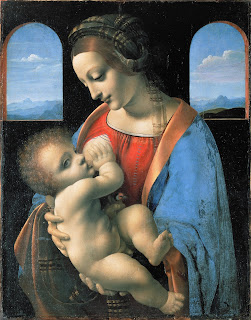 |
Nuestra Senora de la Leche at the Manila Cathedral.
Photo by the author.
|
That week, we saw two newspapers featuring a picture of a group of breastfeeding mothers in their front pages: the Philippine Daily Inquirer and an African broadsheet.
What could be the best icon for breastfeeding? The Virgin Mary in her representation as Nuestra Senora de la Leche (Our Lady of the Milk), or Nuestra Senora de la Leche y Buen Parto (Happy Delivery), or La Virgen de la Leche (The Virgin of the Milk).
I remembered taking a picture of the image of the Nuestra Senora de la Leche in one of the alcoves of the Manila Cathedral in November last year, right beside the large painting of the Filipiniana-dressed Our Lady of the Philippines. The feast day of the breastfeeding Mama Mary is on 11 October. It could be that the image is brought out only for veneration at the cathedral in October to November.
In the image, she holds the baby Jesus nursing on her right breast. She is like any mother opening her blouse anywhere to feed her hungry baby.
In Santiago, Chile, according to reports, the image of La Virgen de la Leche enshrined at the Church of Our Lady of Divine Providence is believed to be miraculous. Many childless couples attend her processions hoping that they be gifted with a child.
Pilgrims to the Holy Land may have visited the Chapel of the Milk Grotto, which is near the Church of the Nativity.
The grotto, according to tradition, is where Mary and Joseph rested during their flight to Egypt to escape the wrath of Herod. While she was nursing the baby Jesus, a few drops of her milk fell on the rocks, and soft yellowish-brown limestone turned creamy white.
Infertile couples, Christians and Muslims, according to pilgrimage accounts, visit the Milk Grotto to seek Mary's intercession for them to have a baby. Muslims have a high regard too for Mary.
The breastfeeding Mama Mary has been the subject of paintings around the time of Leonardo da Vinci. One painting attributed to him, the Madonna and Child (also called the Madonna Litta after its previous owner Count Antonio Litta) at the Hermitage Museum in St. Petersburg, shows Mary nursing the Christ child set against a mountainous scenery framed by symmetrical windows.
 |
| The Madonna Litta, c1490s. Da Vinci. Hermitage Museum. |
The Museo Nacional de Prado [Prado Museum] in Spain has a collection of La Virgen de la Leche paintings.
Several paintings depict Mary nursing on her right breast --
 |
| La Virgen de la Leche. Alvaro de Luna. c1490. |
-- and in this scene, we see Mary's milk spurting after the baby may have had his fill onto St. Bernard of Clairvaux and St. Benedict:
 |
| 'La Vrgen de la Leche con Nino' between St. Bernard of Clairvaux & St. Benedict. Pere Lembri. 1410-1415. |
She is also depicted nursing on her left breast --
 |
| La Virgen de la Leche. Bernard van Orley. c1520. |
In this painting by Orley, there are five angels in the background: a harpist and singers, three of them reading a large music book.
 |
| La Virgen de la Leche. Marinus van Reymerswaele. 1525-1550. |
If not for the title, Reymerswaele's mother and child could be any nursing mother anywhere in the world.
 |
| The Virgin and the Souls of Purgatory. Pedro Machuca, 1517. |
The Machuca painting is described as an intriguing version of the La Virgen de la Leche, 'a symbol of Marian mercy that serves to help the souls of Purgatory.'
Here we see Mary with both of her breasts open, with milk dropping from the right toward the souls below. It appears that the baby wants to help her mother quench the thirst of the souls too.
The beautiful woman feeding her child in these paintings is the epitome of motherhood and motherly love. She is Mama, indeed!
References:
1. The Madonna Litta at The Hermitage at
https://www.hermitagemuseum.org/wps/portal/hermitage/digital-collection/01.+Paintings/29633/?lng=en
2. The La Virgen de la Leche collection at Museo del Prado at https://www.museodelprado.es/coleccion/obras-de-arte?searchObras=la%20virgen%20de%20la%20leche
References:
1. The Madonna Litta at The Hermitage at
https://www.hermitagemuseum.org/wps/portal/hermitage/digital-collection/01.+Paintings/29633/?lng=en
2. The La Virgen de la Leche collection at Museo del Prado at https://www.museodelprado.es/coleccion/obras-de-arte?searchObras=la%20virgen%20de%20la%20leche
No comments:
Post a Comment